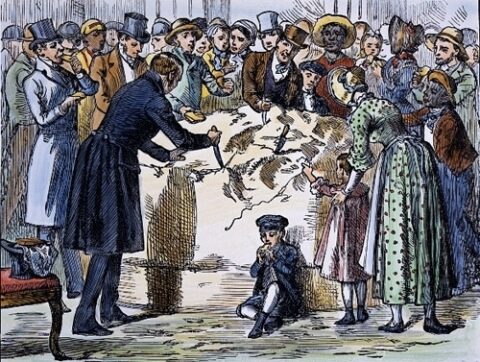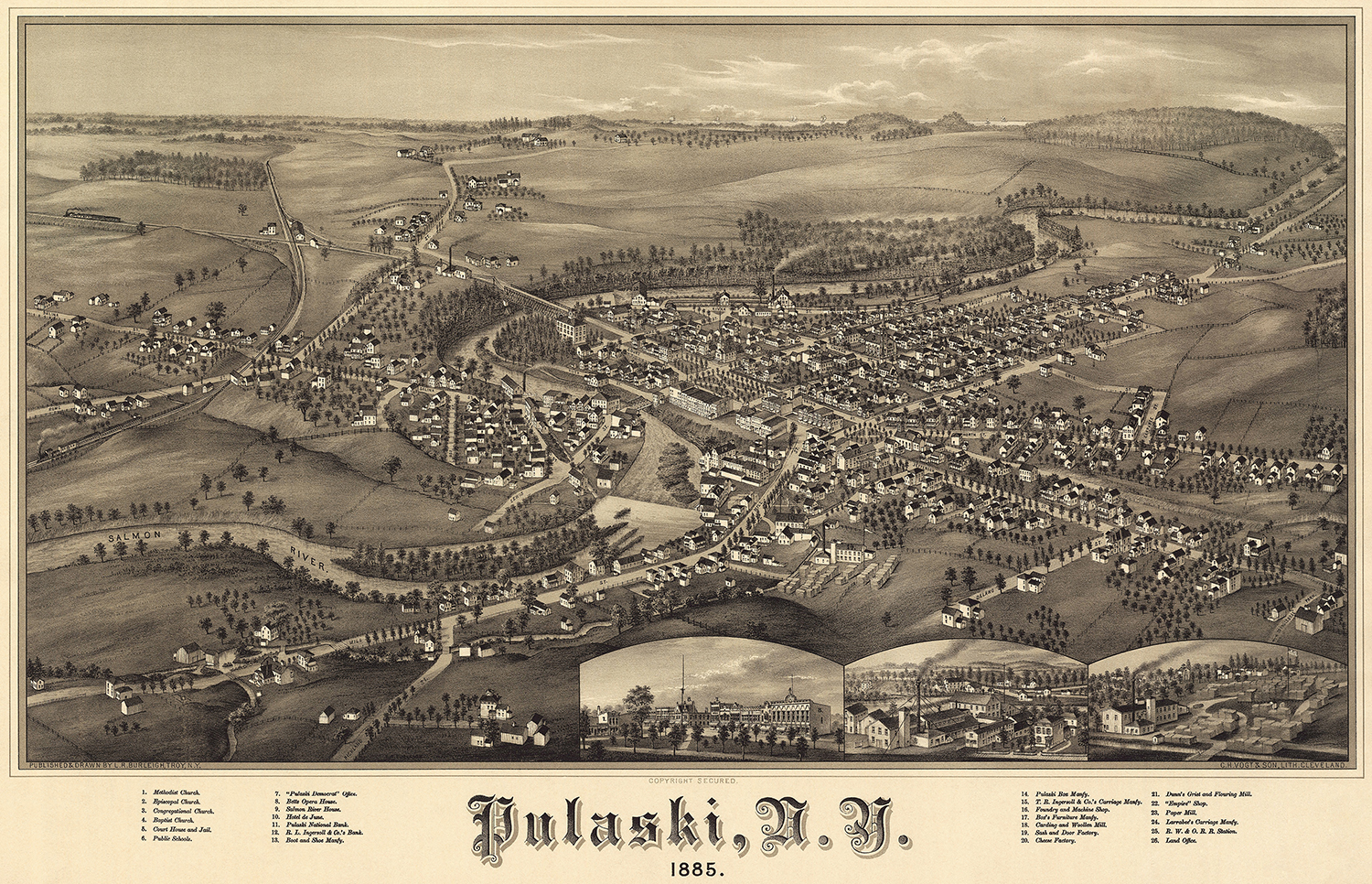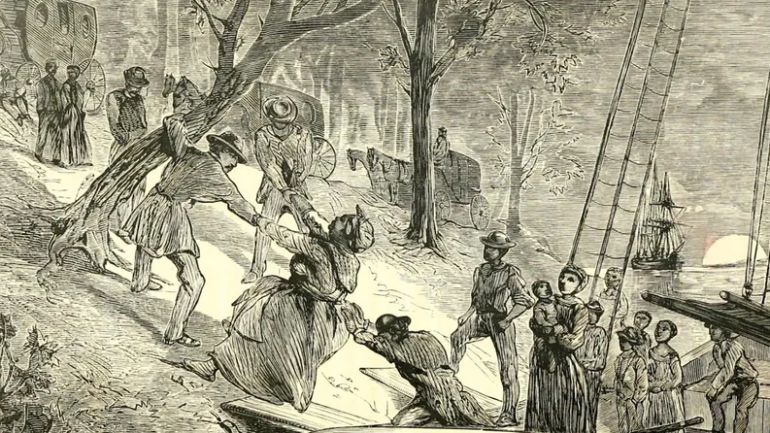This essay was originally published in the 1940 OCHS Yearbook. Please note that this essay was published over 80 years ago. While still useful for general education, language may be outdated and at times offensive. The Oswego County Historical Society does not stand by the language used in this essay. All photos were added in 2024 when this article was uploaded to the web. To view the original document, please visit NYHeritage.org.
Paper Presented Before the Oswego Historical Society, September 30, 1940, by Mrs. F. Earle McChesney of the Pulaski Democrat
I am not going to begin quite as far back as did Washington Irving in his “History of New York,” but in looking up material for this paper I came upon some items that were a surprise to me. For one thing I did not know that the land now occupied by Pulaski was once a part of Albany County. It seems that Nov. 1, 1683 the territory comprising the State of New York was divided into ten counties. Later Albany County was divided and new counties formed. After forming a part of Albany County for almost one hundred years, the territory now included in Oswego County was in Montgomery County for about 20 years. Then for about three years we were in Herkimer County. Then twenty years in Oneida County. March 1, 1816, Oswego County was formed, the part east of the Oswego River being taken from Oneida County and that west of Oswego River from Onondaga County.
The town of Richland was originally a part of Williamstown. It was made a separate town, Feb. 20, 1807. It included at that time the towns of Sandy Creek, Boylston, Albion, Orwell and part of Mexico as well. These other towns were separated from it at different times, the last being Orwell, which was made into a separate town, March 27, 1844, leaving the town of Richland with its present area of 32,251 acres.
Salmon River, so named from the immense quantities of salmon that once swarmed its waters, is not only rich in romantic scenery but also in historic interest. : Then, too, the river afforded another advantage to the settler which was of great practical value. In times of high water large numbers of logs were floated down to the mills that had been built on its banks. Various efforts were made at different times by the state government to retain the fish that gave the river its name in its waters but without permanent results.
A canal was contemplated to furnish the “City” of Port Ontario with water power. Long afterward in 1888 the plan was seriously considered of taking water from our river to supply the city of Syracuse. How amazed our ancestors of those early days would have been if they could have known of the marvelous results that would one day be accomplished by the waters of Salmon River through the development of electric power.
First Town Meeting in 1807
The first town meeting in Richland was held at the house of Ephriam Brewster, east of Pulaski Village, in the spring of 1807. A partial list of the officers chosen included the names of Joseph Hurd, supervisor; William Hale, town clerk; George Harding, John Meacham, and Joseph Chase, assessors; Isaac Meacham and Gersome Hale, overseers of the poor; Simon Meacham, Elias Howe and Jonathan Rhodes, highway commissioners; Elias Howe, Pliny Jones, collectors; George Harding, pound master and a long list “pathmasters”, “fence viewers” and “constables”.
The first settlement in the town, as nearly as I have been able to discover, was at the mouth of Salmon River in 1801. The same year Benjamin Winch also settled near the outlet, but he soon removed to the present site of Pulaski Village .where he opened the first tavern in town about 1806. Being a surveyor he helped in surveying the original town of Richland and was a useful and influential citizen.
Reliable data concerning the early settlers is in many cases lacking. Of those, the exact date of whose settlement here is known, I find there was Thomas Jones who came in 1804 foom Bridgewater, N. Y. He had five sons and three daughters. The sons were Pliny, Israel, Horace, Chauncey and Lyman. They settled at what was long known as “Jones Corners”. L. J. Farmer now living near there was a grandson of Pliny Jones. Israel Jones built the first saw mill in town. The first wedding in town was that of Joseph Spaids and Clara Jones, the grandparents of Dr. J. F. Braduer. Spaids was obliged to go by boat to Oswego for a magistrate to perform the ceremony.
Benjamin Ingersoll, born Aug. 28, 1804, was the first child born in Pulaski.
First School Cost $8,514
The site for the old academy on the bank of the river was purchased in April, 1854, for five hundred dollars and in May the same year the planning and building of the brick structure was commenced. When it was completed and turned over to the New York Board of Regents in 1855 it represented an investment of $8,514.00. Two additions were constructed to the original building at different times and the building served its purpose well till it was destroyed by fire in 1937 and replaced in 1939 by the present splendidly equipped Pulaski Academy and Central school.
The remaining portion of this paper is taken from reminiscences entitled, “Bits From Pulaski” written by Miss Metalill Huntington in 1910 for presentation at the celebration of the One Hundredth Anniversary of the establishment of the Congregational church of Pulaski:
Perhaps it would please you to wander for awhile through our village as if it stood on a foreign shore, and the distant roar of Ontario were the voice of some many-storied lake under the shadow of the Alps, or mirroring at its brink, the purple moors of Scotland. If there were but a guide book—odds and ends of one at least—if my Baedeker but took it in! And why should Pulaski not have a guide book of her own however fragmentary, and why should we not take bits from it to tell us of odd or lovely things?
What would you say to a lost stairway—an outer stairway laid long ago of heavy stone cut from the rocks by the river, then covered level with earth no one knows when or why. What a surprise when a stairway was to be built there, to find the old one, solid and shapely emerging as if just laid. This was located just south of Dr. Abbott’s office.
Early Threat to the Railroads
A few of the fine old doorways and porticos still remain; beautiful with pairs of slender, delicately tapering pilasters or with deep sunken windows of small heavily, sashed panes. One of the finest is in the old Lewis’ house where Canal (now Glenn Ave.) merges into Lewis street. In this Lewis house lived for many years the man for whom it was named, owner of several lines of stages, running between Watertown, Syracuse, Rochester and other cities. When the first railway was built he announced his intention of running them out of business.
The old Methodist church stood on the east side of Salina street, high above the street, on the site where Mrs. Roy Austin’s home now stands.
Do you remember the old Congregational church? I walked to it many a Sunday morning wearing my little Nan-Keen sun bonnet and holding a head of carraway which I had just picked. Then I sat in the high backed pew, so high that I could not see the minister unless I stood on the seat. Over the minister’s head hung a sounding board—a fearful and wonderful thing in my eyes, for I was sure it would fall some day and crush the minister’s head flat.
Do you remember when a row boat was tied to the Mathewson piazza in time of flood and the pigs were rowed safely to dry land? My respect for Spring freshets has been high ever since then.
President Jackson’s Great Cheese

In 1835, Col. Thomas Meacham who lived at Agricultural Hall on the road to Sandy Creek made an immense cheese to be sent as a gift to President Andrew Jackson. It was made from the milk of his own one hundred cows and much more that he bought. When it was completed it was placed on a specially-built dray and drawn downtown by ten white and gray horses each mounted by a boy in uniform. After appropriate ceremonies in front of the court-house, the cheese was drawn to Selkirk and placed on a canal boat, accompanied by a delegation of citizen who were to present it to the President. The President appointed a “Cheese day” in Washington when all the inhabitants were invited to come to the White House to eat the cheese. The large tree which stands north of the former S. P. Carpenter house on the Sandy Creek road now marks the location where the cheese was made.
There was in early days a tribe of Oneida Indians that lived in their wigwams on “the lake road”. The little Indian princess wore a heavy petticoat fringed closely with silver dollars which were to be her dowry when she married.
At one time there was a brewery which stood on the west side of Salina street near where Mrs. William Peach now resides. The house just south of it once was a comb factory. Years later quantities of the combs, cut but not separated, were found in the attic by a small boy of the family who was curious as to what the strange looking articles were.
How Pulaski’s Name Was Chosen
The first building erected in the village was a little log cabin of a tavern located where the Randall Hotel now stands. When the village was to be named, a meeting of the citizens was called at this Winch’s Tavern, to which each one came bringing a name. The one suggested by Mr. Thomas C. Baker, grandfather of Mrs. William Elliott Griffis, who greatly admired Count Pulaski, was the one chosen.
The Village paid $75 to have South Park cleared and freed from stumps. It took a man with his yoke of oxen two weeks to draw out the stumps.
The upper part of Maple Ave., was formerly called “Tallow Hill” because when it was much steeper and the mud much deeper, than now, it was almost impossible for wagons to go up or down it after rain.
Sixty years ago Charles Tollner came to Pulaski to take charge of the tile factory which Mr. Otto had established with his funds. From the first he noticed the bubbles in the river and declared that some day he would heat and light Pulaski with her own gas. It was long before he could carry out his prediction, but at last that day came. He started the electric works also. But I need not dwell upon the great benefits he conferred upon our village—all the older ones recall them as well. What a keen intelligence he had! what a force!—never content unless things were pushed as far as human power could push them.
Many years ago we had with us a Danish sculptor, a pupil of the great Thorwaldsen. Gottfried Borup, heartbroken over the death of his young wife and child, came to America hoping to find courage and inspiration to work. He made the beautiful bas-relief of Thorwaldsen’s “Night” and “Morning” and then encouraged by Mr. Brockman, he moulded the fine bust of Lincoln which bears his name and is prized by connoisseurs.
It is well to look back on “the days of old” and to fix the image of by-gone times more firmly in the mind, that we may recognize the part which the past plays in the present for “Nothing happens without a sufficient reason why it should happen so and not otherwise” and the life of today is woven of strands which were spun in far off years.





